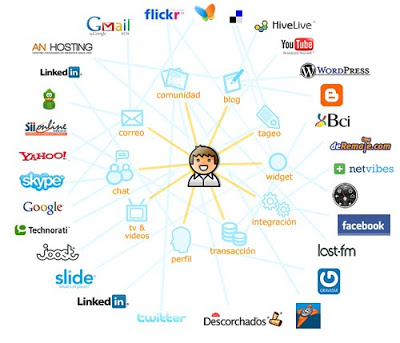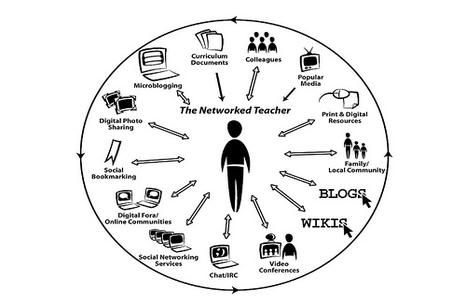Personal Learning Networks
 Consistent with the theories of connectivism and constructivism, a personal learning network (PLN) is a collection of reliable blogs, websites, wikis, twitters, RSS feeds, and other resources that help in learning, acquiring skills and information and remaining connected to new information and people of interest to the user. Personal learning networks can be educational, professional, or personal or a combination. As the number of interesting and relevant resources expands exponentially each day and technology continues to develop and change at seemingly neck-break speed, people need a way to keep up with all that interests them.
Consistent with the theories of connectivism and constructivism, a personal learning network (PLN) is a collection of reliable blogs, websites, wikis, twitters, RSS feeds, and other resources that help in learning, acquiring skills and information and remaining connected to new information and people of interest to the user. Personal learning networks can be educational, professional, or personal or a combination. As the number of interesting and relevant resources expands exponentially each day and technology continues to develop and change at seemingly neck-break speed, people need a way to keep up with all that interests them.
Although the idea of a personal learning network (PLN) is not new (Tobin 1998), the advent of wireless technology, the PLN provides a convenience to learning that has never before existed. In addition to the removal of barriers to time and place, the online PLN also conserves time. Information is organized and available at the user's fingertips. These developments in technology that have allowed learning to take place at any time and in any place, promote the life-long learning so imperative in our ever-changing world. The classroom has spilled out into the world and internet; personal learning networks have a more prominent place in learning than ever before.
 A PLN provides organization for current resources. Many online programs can assist in the organization of the resources and creation of the PLN. The use of aggregates, for example, assists in this organization by gathering information from each and displaying it. Programs such as Netvibes and Google Reader ( o longer aviailable) not only display and check favorite sites and blogs for updates, but it finds sites of similar interest.
A PLN provides organization for current resources. Many online programs can assist in the organization of the resources and creation of the PLN. The use of aggregates, for example, assists in this organization by gathering information from each and displaying it. Programs such as Netvibes and Google Reader ( o longer aviailable) not only display and check favorite sites and blogs for updates, but it finds sites of similar interest.
Hootsuite is the self-described social media dashboard, providing access to subscribed sites such as twitter and facebook from one site; bookmarking sites such as Delicious and Symbaloo aid in organization of online resources for the learner as well. Instapaper and LaterThis provide a service that allows bookmarking of sites to be read at a later date. Notefish, Mashup,and Evernote provide online spaces where information can be stored and accessed any place, any time. Skype and Zorap provide communication tools of different types. Creating a PLN is a matter of sifting through the plethora of available organizing tools and resources to locate the best for the user's specific purposes.
Building a personal learning network may seem daunting given the number of resources available. The simplest beginning may be to select useful aggregates then adding to them carefully. Articles such as Wikipedia's Comparison of Feed Aggregators can aid in this selection. Each site added to the network should be examined carefully to include only the best and most useful resources for the learner. By choosing each resource carefully, the network remains tailored to each author.The site should be monitored for usefulness, and if it is found to be substandard for the users purposes, should be removed so as to build the most organized, effective, and useful PLN.
Skip Via of the University of Alaska School of Education believes that the PLN should not be passively utilized. By participating in discussion boards, blogging, and publishing original or mashed works, learners should add to the collective online intelligence of the community. He, and others, believe that it a responsibility as a member of the community of practice (CoP). Members of a particular community, bound by common interest posting original works, mashing of works, opinion pieces, links to works of interest and so on creating, revising, and maintaining the body of information common to them all.
PLN's for Educators
By subscribing to specific websites, blogs, channels, and the like, one can stay abreast of professional developments and information. Some sites have recognized this need and created places online for like-minded people to meet for example, the Educator's PLN is a Ning page dedicated to bringing educators together to learn from one another. However, PLNs are not exclusive to professionals; they are also useful for people in the various roles that they play in their lives. A parenting network can help parents remain informed. Students can build their own PLN and personal learning environments as they work on project, problem, and inquiry based projects. PLN can evolve as students progress throughout their academic careers and, indeed, their lives.
Next up, see Concluding Thoughts on Education 2020
